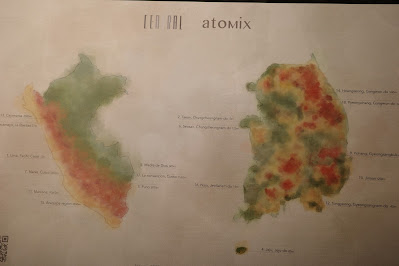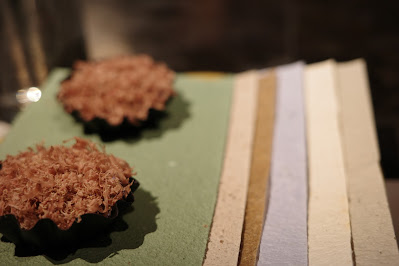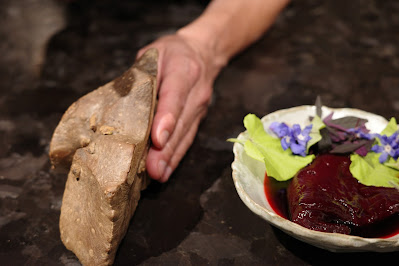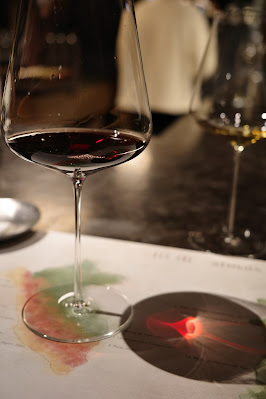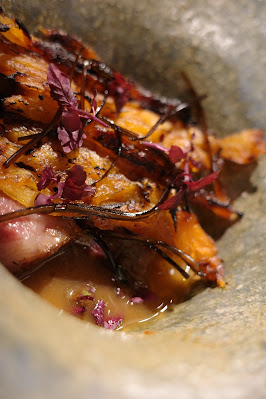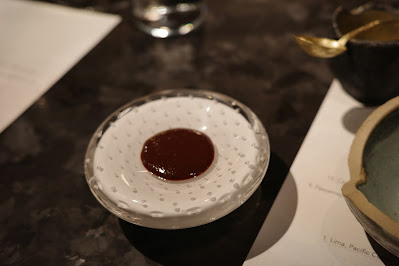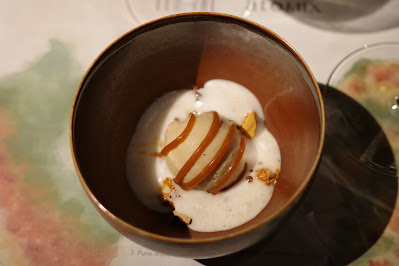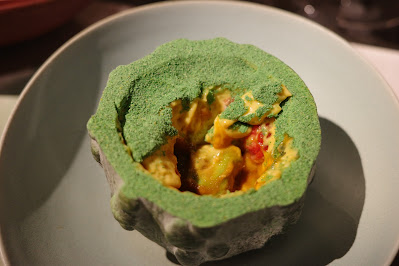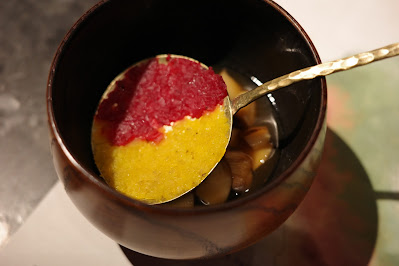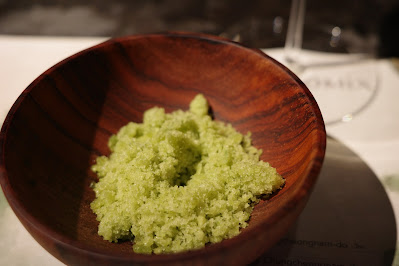Opening Thoughts
Many restaurants can be seen as a sum of what their dishes express. The best ones make their courses memorable, interesting, and offer something unique, as they try to make an indelible mark on your memory with their signature, normally something rich, flavorful, and impactful.
Compared to these signatures, none of the individual dishes at Atomix seem to be especially remarkable. Rather than making its mark with showstoppers, the courses simply flow, as if it's telling a story of Junghyun and Ellia Park's experience with the seasons and the places and the ingredients found within.
The Courses
 |
| Pumpkin crispy, Sorghum, Foie gras, Finger lime |
 |
| Striped beakfish, Black truffle, Yuza, Yangha ginger. |
Part of what helps the dishes flow is that the flavors aren't particularly assertive. For example, the truffle in the beakfish doesn't overwhelm, but adds to the layers created by the Yuza (yuzu) creme fraiche and the ginger, bringing a savory earthiness.
 |
| Sweet shrimp, Eggplant, Tomato, Salmon roe |
At the core of of the sweet shrimp dish, is an eggplant layered with king crab innards. Although the ingredients on their own would be delightful in texture, specific additions help turn the dish into something more akin to a spectrum despite the distinct textures -- the doenjang balancing the king crab innard, the dashima and the fermentation leading the tomato gel, and the sweetness of the shrimp highlighted from it all.
The overall seafood courses feel quite rich, and although there's a bit of sourness and acidity offered at each course to balance, a bit of wine goes a long way for these courses. We brought two bottles of wine for the occasion ($100 per bottle, 2 bottles per party -- I'm still praying that they will allow more than two bottles for larger parties!), and the champagne we brought (a 2008 Louis Roederer Cristal) worked extremely well with these courses -- as it offered a precise and yet potent glass that played off its minerality with the courses richness and salinity. The champagne worked its way until the Filefish course.
The second bottle we brought (2005 Nicolas Potel Clos Saint-Denis) was brought out for the songyi (Matsutake) course -- one of the dishes I was most looking forward to.
 |
Songyi, King crab, Quail egg, Galangal broth
|
The wine paired surprisingly well with the dish, the earthiness from both parties to highlight the other elements of each other. The crab, the quail egg, and broth was excellent -- although it was quite disappointing that the songyi's flavor was extremely understated for the dish -- almost as if it was only added to the dish to add a bit of flavor and texture, elevating the King crab.
The course was when I noticed that a lot of the ingredients that one would expect would play a bigger role -- for example, the truffle and the songyi, only served a secondary role, serving to highlight the beakfish and the king crab.
 |
| Butterfish, Gochugaru, Sesame seed |
The observation became quickly reversed as soon as I realized it -- where the proteins began to highlight the condiment they were served with.
This Butterfish dish was interactive, as the fish, the foam, the caviar all allowed the dish to hit wide spectrum of flavors. However, it was almost as if the dish was made to highlight the gochugaru, as the softness of the Butterfish and the sweetness of the sauce, and the flavors of the caviar all ended with the spice.
 |
| Green circle chicken, Ehwaju, Popcorn, Black currant |
The chicken serves as the canvas that the Ehwaju puree bounces from, encouraged by the currant. The focus was less on the chicken, but on the Ehwaju -- much like the unripe blueberry seems to be the focal point of the pork rack.
The Huckleberry dish served as a great palate cleanser and a great lead up to my favorite dish of the night, the Pine nut ice cream.
 |
Pine nut ice cream, Cinnamon curd, Pine cone
|
This probably stands to be one of the best desserts I've had this year -- the attempts of putting pine nuts in ice cream and making it stand out fully pays off, as it really does capture the many charms of pine nut -- unveiling the particular oily nuttiness that plays off the syrups and the cinnamon, reminiscent of Sujeongwa, but with pine nuts as the dominant character.
Some Thoughts
The overall experience is extremely personable. Whether it be from the staff that makes an effort to get to know you, choosing your utensils at the start of your meal (we didn't get do this, as we ran a little late), and from the cards that carry with it the chef's story and experiences -- it adds a lot of homeliness that almost feels lacking in a big city. Rather than focusing on big dazzling experiences, Atomix seems to focus on the little things that elevate the experience.
Meaning that rather than slapping you with combinations of truffles, carbs, fats, and salt to leave an impression, Atomix promotes nuance and subtlety. Much of the use of their sauces and seasoning seems easy to miss, especially without reading the story and ingredient cards provided with every course. There's a heavy use of age -- the jangs (Korean condiments that involve fermenting), preserving, and other ferments are found all throughout the meal. These ferments either balance or accentuate, and observing how these ingredients are impacted by these choices are a delight.
A menu that's focused on such nuances are a rarity. Meaning that an excellent wine can carry itself throughout the meal -- making the corkage an extremely good opportunity, although the pairings also seem extremely thoughtful and interesting.
However, while the food pairs well with the wine, the food does not always seem to pair well with one another. Much of the courses of Atomix come in pairs such as the Filefish with the Dubu (Tofu), the Butterfish accompanied by the veal sweetbread, or the Chicken dish soothed out with the Jook. Sometimes they're meant to be banchan (side dishes), sometimes they're meant to be the carbohydrate addition, but at best, they work well as separate dishes, and at worse, they overwhelm each other. The worst offender being the Filefish with the Dubu, with the richness of the Filefish liver overwhelming the nectarine and sea urchin with the Dubu, to the point where the ingredients seemed wasted. Jook in general needs a bit of salt and spice to eat it with, and having it as as separate dish with the Flounder sikhae would have made great use of both courses, rather than them playing second fiddle to the Chicken and Pork Rack.
A Short Summary
Atomix feels like a picture book, where the dishes served as the illustrations. It depicts a story of the seasons and the ingredients found within, and while there were moments where some of the ingredients could have done more, the overall story makes up for it all.
Overall Rating: B+: Would return frequently. A thoughtful experience that offers something new. Would love to see how the restaurant evolves with the seasons and with time.
PS: Sorry for the lack of posts -- there's a lot of thoughts to organize and compose regarding what I want to express in terms of tea currently. Soon!
